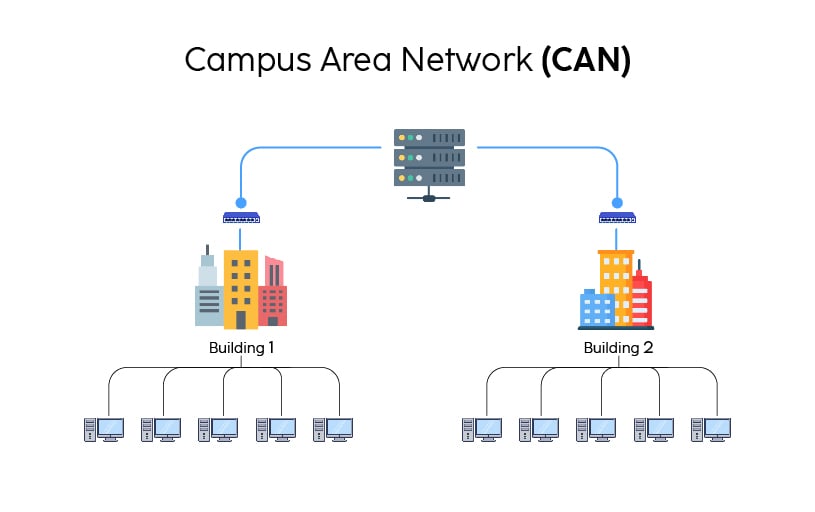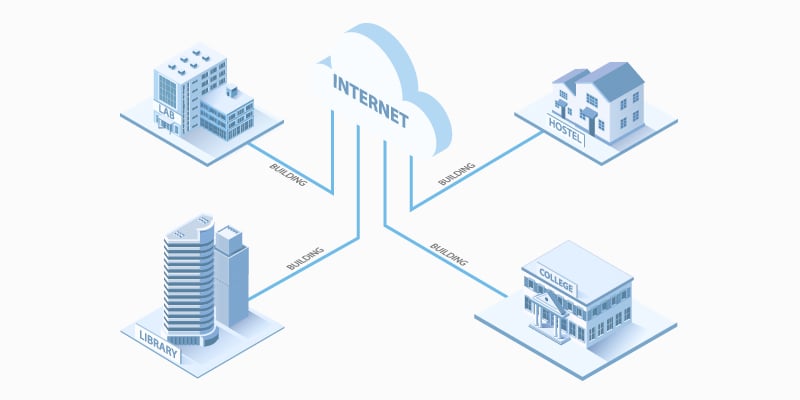What is a Campus Area Network (CAN)?
In an era where digital connections have become the lifeblood of our daily operations, understanding the anatomy of the networks we rely upon becomes crucial. Here, we explore one such powerful tool, the Campus Area Network (CAN). Whether you’re a seasoned IT professional, a student, or just someone curious about the digital realm, this blog will equip you with the knowledge you need about campus area networks. We’ll delve into the benefits, use cases, and operational mechanisms that make a campus area network indispensable.
What is a campus area network (CAN)?
A campus area network (CAN) is a computer network that spans a limited geographic area. CANs interconnect multiple local area networks (LAN) within an educational or corporate campus. Most CANs connect to the public Internet.
CANs are smaller than metropolitan area networks (MAN) and wide area networks (WAN), which stretch over large geographic areas. Typically, the organization that owns the campus also owns and operates all the networking equipment and infrastructure for the CAN. In contrast, MANs and WANs may combine infrastructure operated by several different providers.
At colleges, universities, and other educational institutions, CANs provide Internet access for students and faculty. CANs also enable connected users to quickly share files and data within the network. Since data does not have to leave the CAN, users experience far less latency than they would when sending and receiving data within a MAN or WAN. Suppose a university’s English department requests digital copies of several books from the university library. Because those digital book copies only have to travel the distance between the English building and the library building (assuming both buildings have their own servers), the English department receives them far faster than it would if the library had to send the files over the public Internet.
Corporate facilities large enough to be considered a “campus” may also operate CANs for the same purposes.

Why are Campus Area Networks Important?
In a world that is increasingly becoming interconnected, the significance of Campus Area Networks cannot be overstated. Imagine a sprawling university campus with thousands of students, multiple buildings, and an array of devices requiring internet access. A well-implemented campus network can seamlessly cater to these demands, providing high-speed, reliable connectivity throughout the campus.
Moreover, a CAN aids in centralizing the IT infrastructure, leading to increased efficiency and easier maintenance. By having all network resources under a single umbrella, organizations can better manage their network security, quality of service, and other policy controls. This capability not only simplifies the administrative workload but also paves the way for improved performance and security.
How does the CAN work?
A CAN is made up of multiple interconnected LAN networks and thus allows you to connect multiple devices, such as computers, printers, servers, etc., within a limited geographic area.
The CAN infrastructure is usually made up of switches and access points that link the devices together, allowing them to communicate with each other. In a CAN, the devices are connected using wired and wireless technologies, such as Ethernet and Wi-Fi. The wired connections are usually faster and more reliable, while the wireless connections offer greater flexibility and mobility.
Once the CAN is set up, a central IT team manages it while ensuring that the network is secure, up-to-date, and able to handle the high bandwidth demands of the users. The IT team is also responsible for monitoring the network traffic, configuring the network settings, and troubleshooting any issues.
Key Benefits of Campus Area Networks
While a campus network’s primary advantage lies in its aptness for a limited geographical area, the benefits extend well beyond geographical appropriateness. Here are a few key benefits that make CANs so instrumental in today’s digital world.
Enhanced Security in CANs
With cyber threats looming large, network security is a prime concern for all organizations. Campus Area Networks, given their localized reach, offer a higher degree of control, leading to enhanced security. IT teams can quickly detect, isolate, and address potential vulnerabilities or threats, offering a more secure network environment. For instance, if there’s a security breach in one of the university buildings, the IT team can isolate that network segment to prevent the spread, ensuring the rest of the campus network remains unaffected.
Centralized Control in CANs
Managing a network spread across a wide area can be daunting. A Campus Area Network offers centralized control, simplifying network management. IT administrators can monitor and maintain all connected devices, update security protocols, and resolve network issues from a central location. This centralized control also enables easier enforcement of organizational policies across the entire network.
High-Speed Data Transmission in CANs
In environments such as universities and corporate campuses where high-speed data transmission is critical, Campus Area Networks deliver. Since the network is confined to a smaller area, data transmission is typically faster and more efficient. This high-speed connection improves productivity, whether it is students downloading study materials or corporate teams collaborating on large files.

Practical Use Cases of a Campus Area Network
Campus Area Networks (CANs) are enablers of modern education and research. Practical use cases of CANs in educational settings include:
- Streamlined Administrative Operations: Automating processes like enrollment, scheduling, and student record management.
- Enhanced E-Learning: Supporting online courses, digital libraries, and virtual classrooms.
- Campus Safety: Integrating surveillance systems and emergency communication networks.
The Future of CANs
As digital connectivity becomes increasingly essential, the role of Campus Area Networks in creating stable and secure networks is set to grow. We can anticipate the introduction of more sophisticated technology into CANs, including AI-powered network management and advanced cybersecurity solutions.
One significant future trend is the role of cellular access points and private 5G deployments in CANs. These technologies can further boost the speed and efficiency of campus networks, making them even more suitable for environments requiring real-time data transmissions, such as autonomous vehicle testing on a university campus or real-time monitoring of production parameters in an industrial complex.
Conclusion
Campus Area Networks are generally economical, easy to implement, and beneficial. It is helpful in universities and corporate organizations that work across several blocks by providing a shared network between administrative offices, staff rooms, common rooms, conference halls, hostels, gymnasiums, and other areas.